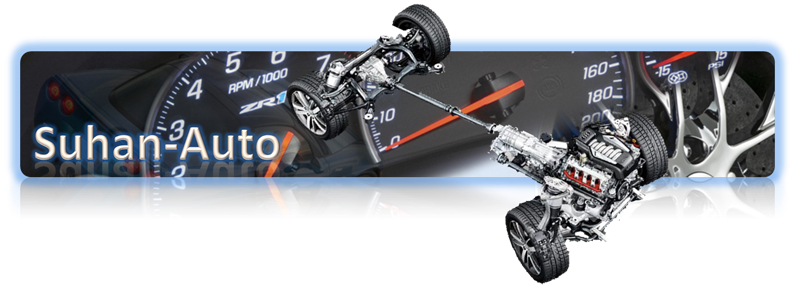Adaptive air suspension is an electronically controlled air suspension system at all four wheels with a continuously adaptive damping system. It unites sporty handling and a high level of ride comfort. In addition, the air suspension allows the speed-dependent lowering of the body – this change in ride height means a low centre of gravity and significantly increased directional stability as a result. The vehicle’s aerodynamics are improved at the same time.
The vehicle has air suspension struts on all four wheels. The data from sensors on the axles and acceleration sensors on the body is evaluated in the adaptive air suspension's central control unit. This computer controls the adjustment of the individual shock absorbers in milliseconds depending on driving situation. Provided no higher damping forces are required – for instance when driving straight ahead on good roads – the damper settings remain comfortably soft.
Controlled changes to the damping force at individual wheels help to eliminate body movements at any time which could reduce occupant comfort. The adaptive damping system automatically reduces rolling or pitching movements when cornering, braking or driving off. Adaptive air suspension moreover offers the advantages of a traditional self-levelling suspension system. The vehicle's suspension height remains constant irrespective of the load it is carrying.
The adaptive air suspension generally also allows the driver to influence the suspension characteristic – and thus the operating dynamics – as individually preferred. The damping characteristics and ride height can be adjusted in a single process via the MMI "CAR" menu system. Adaptive air suspension (sport), which is available as an option in the Audi A8, is the first Audi sports suspension system to be based on the principle of air suspension.
Adaptive Air Suspension Basic Principle
When the vehicle is being loaded, unloaded, or lowered due to driver command or vehicle speed, the electronic readings from the height sensor monitor the change. This is picked up by the electronic control unit and compared to the stored reference values.
The ECU either activates the electric motor of the compressor, or the exhaust solenoid valve. This also requires the solenoid valve block to be actuated, in order to maintain the required level. The corner solenoid valves are subject to stringent leakage requirements to maintain the vehicle’s height even without system operation.
When the vehicle is being loaded, the compressor delivers air into the four air suspension bellows, until the normal level has once again been reached. For additional air delivery or rapid response, the reservoir solenoid valve is opened and air flows directly from the reservoir.
When the vehicle is being unloaded, the solenoid valve block is activated. This results in airflow from the air suspension bellows being removed via the air dryer solenoid valve in the compressor, then via the relay valve. The air is then exhausted into the atmosphere.
Reference:
http://moodle.student.cnwl.ac.uk/
Audi Glossary
Adaptive Air Suspension Basic Principle
IMG Ref: http://moodle.student.cnwl.ac.uk/
When the ignition is switched on, or when the vehicle’s door is opened before ignition, the control system is activated. The height sensor uses the induction principle to constantly monitor the distance between the vehicle’s axle and its chassis.When the vehicle is being loaded, unloaded, or lowered due to driver command or vehicle speed, the electronic readings from the height sensor monitor the change. This is picked up by the electronic control unit and compared to the stored reference values.
The ECU either activates the electric motor of the compressor, or the exhaust solenoid valve. This also requires the solenoid valve block to be actuated, in order to maintain the required level. The corner solenoid valves are subject to stringent leakage requirements to maintain the vehicle’s height even without system operation.
When the vehicle is being loaded, the compressor delivers air into the four air suspension bellows, until the normal level has once again been reached. For additional air delivery or rapid response, the reservoir solenoid valve is opened and air flows directly from the reservoir.
When the vehicle is being unloaded, the solenoid valve block is activated. This results in airflow from the air suspension bellows being removed via the air dryer solenoid valve in the compressor, then via the relay valve. The air is then exhausted into the atmosphere.
Reference:
http://moodle.student.cnwl.ac.uk/
Audi Glossary


nice!!
ReplyDelete